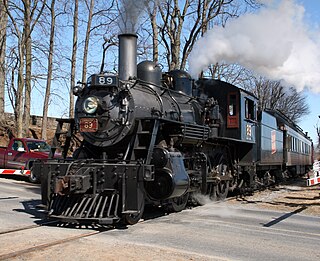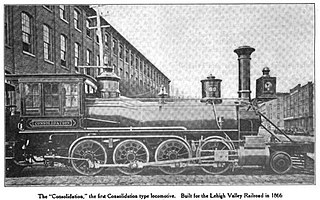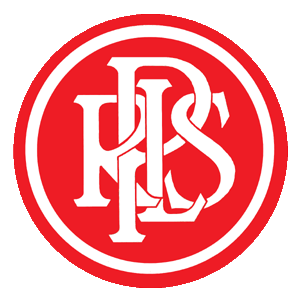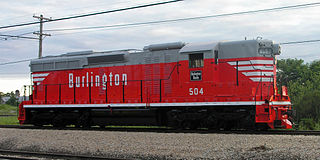The Pennsylvania Railroad was an American Class I railroad that was established in 1846 and was headquartered in Philadelphia. Named for the commonwealth it was established in, by 1882, the Pennsylvania Railroad had become the largest railroad, the largest transportation enterprise, and the largest corporation in the world. Its budget was second only to the U.S. government.

Under the Whyte notation for the classification of steam locomotives, 4-8-2 represents the wheel arrangement of four leading wheels, eight powered and coupled driving wheels and two trailing wheels. This type of steam locomotive is commonly known as the Mountain type.

The New York Central Railroad (NYC) called the 4-8-2 type of steam locomotive the Mohawk type. It was known as the Mountain type on other roads, but the New York Central didn't see the name as fitting on its famous Water Level Route. Instead, it picked the name of one of those rivers its rails followed, the Mohawk River, to name its newest type of locomotive. Despite the more common name, the 4-8-2 was actually suited in many ways more to flatland running than slow mountain slogging, with its 4-wheel leading truck for stability at speed. However, the L1s and L2s were unstable at higher speeds due to the design of their reciprocating gear, making the 4-wheel leading truck simply a better distributor of the locomotives' weight; the L1s and L2s were consequently limited to 60 mph (97 km/h), but this issue was resolved for the L3s and L4s.

Under the Whyte notation for the classification of locomotives, 4-6-4 represents the wheel arrangement of four leading wheels, six powered and coupled driving wheels and four trailing wheels. In France where the type was first used, it is known as the Baltic while it became known as the Hudson in most of North America.

Under the Whyte notation for the classification of steam locomotives, 4-8-4 represents the wheel arrangement of four leading wheels on two axles, eight powered and coupled driving wheels on four axles and four trailing wheels on two axles. The type was first used by the Northern Pacific Railway, and initially named the Northern Pacific, but railfans and railroad employees have shortened the name since its introduction. It is most-commonly known as a Northern.

Under the Whyte notation for the classification of steam locomotives, 4-2-0 represents the wheel arrangement of four leading wheels on two axles, two powered driving wheels on one axle and no trailing wheels. This type of locomotive is often called a Jervis type, the name of the original designer.

Under the Whyte notation for the classification of steam locomotives, 2-6-0 represents the wheel arrangement of two leading wheels on one axle, usually in a leading truck, six powered and coupled driving wheels on three axles and no trailing wheels. This arrangement is commonly called a Mogul.

Under the Whyte notation for the classification of steam locomotives, 2-8-0 represents the wheel arrangement of two leading wheels on one axle, usually in a leading truck, eight powered and coupled driving wheels on four axles, and no trailing wheels. In the United States and elsewhere, this wheel arrangement is commonly known as a Consolidation, after the Lehigh and Mahanoy Railroad’s Consolidation, the name of the first 2-8-0.
Locomotive classification on the Pennsylvania Railroad took several forms. Early on, steam locomotives were given single-letter classes. As the 26 letters were quickly assigned, that scheme was abandoned for a more complex system. This was used for all of the PRR's steam locomotives, and — with the exception of the final type bought — all electric locomotives also used this scheme.

The Pennsylvania-Reading Seashore Lines was a railroad that operated in southern New Jersey in the 20th century. It was created in 1933 as a joint consolidation venture between two competing railroads in the region: the Pennsylvania Railroad and the Reading Company.

In the Whyte notation for the classification of steam locomotives by wheel arrangement, a 2-8-8-0 is a locomotive with a two-wheel leading truck, two sets of eight driving wheels, and no trailing truck. These were nicknamed "Bull Mooses".

The St. Louis–San Francisco Railway, commonly known as the "Frisco", was a railroad that operated in the Midwest and South Central United States from 1876 to April 17, 1980. At the end of 1970, it operated 4,547 miles (7,318 km) of road on 6,574 miles (10,580 km) of track, not including subsidiaries Quanah, Acme and Pacific Railway and the Alabama, Tennessee and Northern Railroad; that year, it reported 12,795 million ton-miles of revenue freight and no passengers. It was purchased and absorbed into the Burlington Northern Railroad in 1980. Despite its name, it never came close to San Francisco.

The EMD SD24 was a 2,400 hp (1,800 kW) six-axle (C-C) diesel-electric locomotive built by General Motors' Electro-Motive Division of La Grange, Illinois between July 1958 and March 1963. A total of 224 units were built for customers in the United States, comprising 179 regular, cab-equipped locomotives and 45 cabless B units. The latter were built solely for the Union Pacific Railroad.

The Chicago, Milwaukee, St. Paul and Pacific Railroad classes EP-1 and EF-1 comprised 42 boxcab electric locomotives built by the American Locomotive Company (Alco) in 1915. Electrical components were from General Electric. The locomotives were composed of two half-units semi-permanently coupled back-to-back, and numbered as one unit with 'A' and 'B' suffixes. As built, 30 locomotives were assigned to freight service, classified as EF-1 and numbered 10200–10229. The remaining twelve locomotives were assigned to passenger service as class EP-1, numbered 10100–10111, with higher-speed passenger gearing. The design was highly successful, replacing a much larger number of steam locomotives, cutting costs and improving schedules. General Electric self-proclaimed this electric locomotive to be the “King of the Rails” in a silent promotional film from 1915.

Southern Railway 4501 is a preserved Ms class 2-8-2 "Mikado" type steam locomotive built in October 1911 by the Baldwin Locomotive Works in Philadelphia, Pennsylvania as the first of its wheel arrangement type for the Southern Railway (SOU). In 1948, the locomotive was retired from the SOU in favor of dieselization and was sold to the shortline Kentucky and Tennessee Railway (K&T) in Stearns, Kentucky to haul coal trains.

Class D16 on the Pennsylvania Railroad was their final development of the 4-4-0 "American" type of steam locomotive. A total of 429 of these locomotives were built at the PRR's Juniata Shops, spread across five subclasses; some had 80 in (2,030 mm) diameter driving wheels for service in level territory, while others had 68 in (1,730 mm) drivers for mountainous terrain. In the pre-1895 scheme, these locomotives were second class L.

Santa Fe 3415 is a preserved class 3400 4-6-2 "Pacific" type steam locomotive built in 1919 by Baldwin for the Atchison, Topeka and Santa Fe Railway. Retired in 1954, it sat in Eisenhower Park in Abilene, Kansas until 1996. At that point, it was put on display in the Abilene and Smoky Valley yard. Restoration began in 2005 and was completed in early 2009. As of 2022, No. 3415 is out of service at the Abilene and Smoky Valley Railroad.

Chicago and North Western 1385 is a standard gauge class "R-1" 4-6-0 "Ten Wheeler" type steam railway locomotive built in March 1907 by the American Locomotive Company (ALCO) for the Chicago & North Western Railway (C&NW). It was used for hauling freight and passenger trains on the C&NW trackage until its retirement in 1956. In 1961, it was purchased by a preservation group that is known today as the Mid-Continent Railway Museum, and they have operated No. 1385 on several excursions on their tourist railroad, as well as the C&NW mainline, until 1998. As of 2022, No. 1385 is currently being rebuilt for operational purposes.
The Fort Wayne Railroad Historical Society (FWRHS) is a non-profit group in New Haven, Indiana that is dedicated to the restoration and operation of the ex-Nickel Plate Railroad's steam locomotive no. 765 and other vintage railroad equipment. Since restoration, the 765 was added to the National Register of Historic Places as no. 96001010 on September 12, 1996 and has operated excursion trains across the Eastern United States. In 2012, the FWRHS's steam locomotive no. 765 was added to the Norfolk Southern's 21st Century Steam program.

Western Maryland Scenic Railroad No. 734, also known as Mountain Thunder, is a preserved class "SC-1" 2-8-0 "Consolidation" type steam locomotive originally built by the Baldwin Locomotive Works in 1916 for the Lake Superior and Ishpeming Railroad. The locomotive was built for service as a dock switcher and was originally LS&I No. 18. In 1923, the LS&I purchased the Munising, Marquette & Southeastern Railroad and the engine was renumbered to No. 34. It served the LS&I until it was retired from revenue service in 1961. In 1963, it was sold to the Marquette and Huron Mountain Railroad, but never operated under the M&HR flag. In 1971, the locomotive was sold to the Illinois Railway Museum for static display. Since 1991, No. 734 has been owned by the Western Maryland Scenic Railroad in Cumberland, Maryland, though it has not operated since April 2016. It is currently awaiting evaluation for potential overhaul.

















